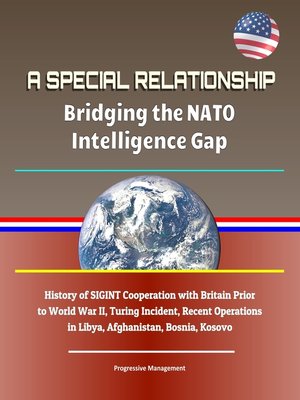A Special Relationship
ebook ∣ Bridging the NATO Intelligence Gap--History of SIGINT Cooperation with Britain Prior to World War II, Turing Incident, Recent Operations in Libya, Afghanistan, Bosnia, Kosovo

Sign up to save your library
With an OverDrive account, you can save your favorite libraries for at-a-glance information about availability. Find out more about OverDrive accounts.
Find this title in Libby, the library reading app by OverDrive.



Search for a digital library with this title
Title found at these libraries:
| Library Name | Distance |
|---|---|
| Loading... |
This important study has been professionally converted for accurate flowing-text e-book format reproduction. Despite NATO's long history of close military cooperation and coordination, the Alliance cannot fully support major multinational operations. Tested by conflicts in the 1990s through to the recent war in Libya, NATO capabilities have consistently fallen short. During each conflict, intelligence played a key role in securing victory, but NATO's operational successes were made possible only through substantial U.S. intelligence support. The lack of an independent NATO intelligence capability presents a problem for the United States, which needs a NATO capable of conducting operations in the event of a simultaneous conflict in another region.
Given the rise of austerity measures in Europe, it is unlikely that European governments will provide additional funding to establish a comprehensive NATO intelligence capability. Therefore, the U.S. should establish an enhanced intelligence-sharing relationship with NATO to offset the paucity of NATO intelligence support and operational resources. Intelligence sharing can increase international cooperation and allow for greater burden sharing among allies. This is most aptly demonstrated by the United Kingdom-U.S.A. (UKUSA) series of signals intelligence agreements developed during World War II, which arguably provided the foundation for the "special relationship" between the U.S. and the U.K. today.
I. Introduction * A. Major Research Questions * B. Importance * C. Problems * D. Literature Review * E. Methods and Sources * F. thesis Overview * II. NATO Intelligence and U.S. Intelligence: Separate But Not Equal * A. NATO: the Influence of Intelligence Assessments * B. Early Days of the Transatlantic Bargain To the End of the Cold War * 1. Why NATO Intelligence Estimates Matter * 2. NATO Intelligence: Design For Dysfunction * C. NATO's Post-Cold War Strategy and Evolution * 1. Overview of Events and Operations In Bosnia 1992-1995 * 2. NATO Intelligence Difficulties In Bosnia and U.S. Sharing * 3. Overview of Events and Operations In Kosovo 1999 * 4. NATO Intelligence Difficulties In Kosovo and U.S. Sharing * D. NATO and Afghanistan * 1. A New NATO Intelligence Structure - the NIFC * E. Overview of Events and Operations In Libya 2011 * 1. NATO Intelligence Difficulties In Libya and U.S. Sharing * F. Conclusion * III. An Enduring "Special Relationship": UK-USA * A. Introduction * B. U.S. War Planning 1920-1941 * C. The Beginning of Signals Intelligence Cooperation * D. The Turing Incident * E. A New Formula for Sigint Cooperation * F. the Effect of the Agreement * G. Conclusion * IV. Conclusion * A. Introduction * B. Summary of Previous Chapters * C. Reasons For Creating A Special Relationship * D. Intelligence-Sharing theory: Building An Anarchic Institution * E. Conclusion And Policy Recommendations
This compilation includes a reproduction of the 2019 Worldwide Threat Assessment of the U.S. Intelligence Community.







